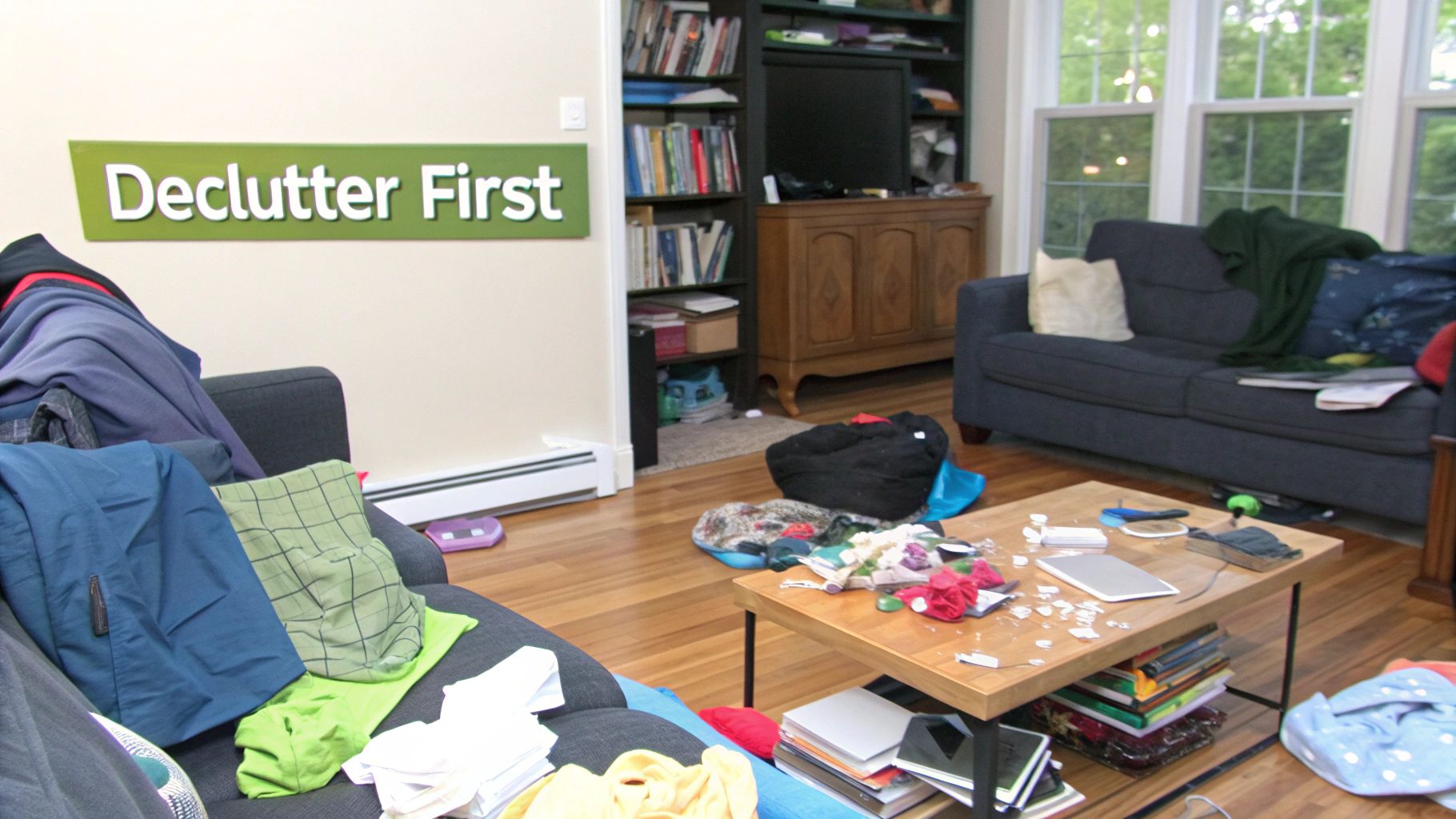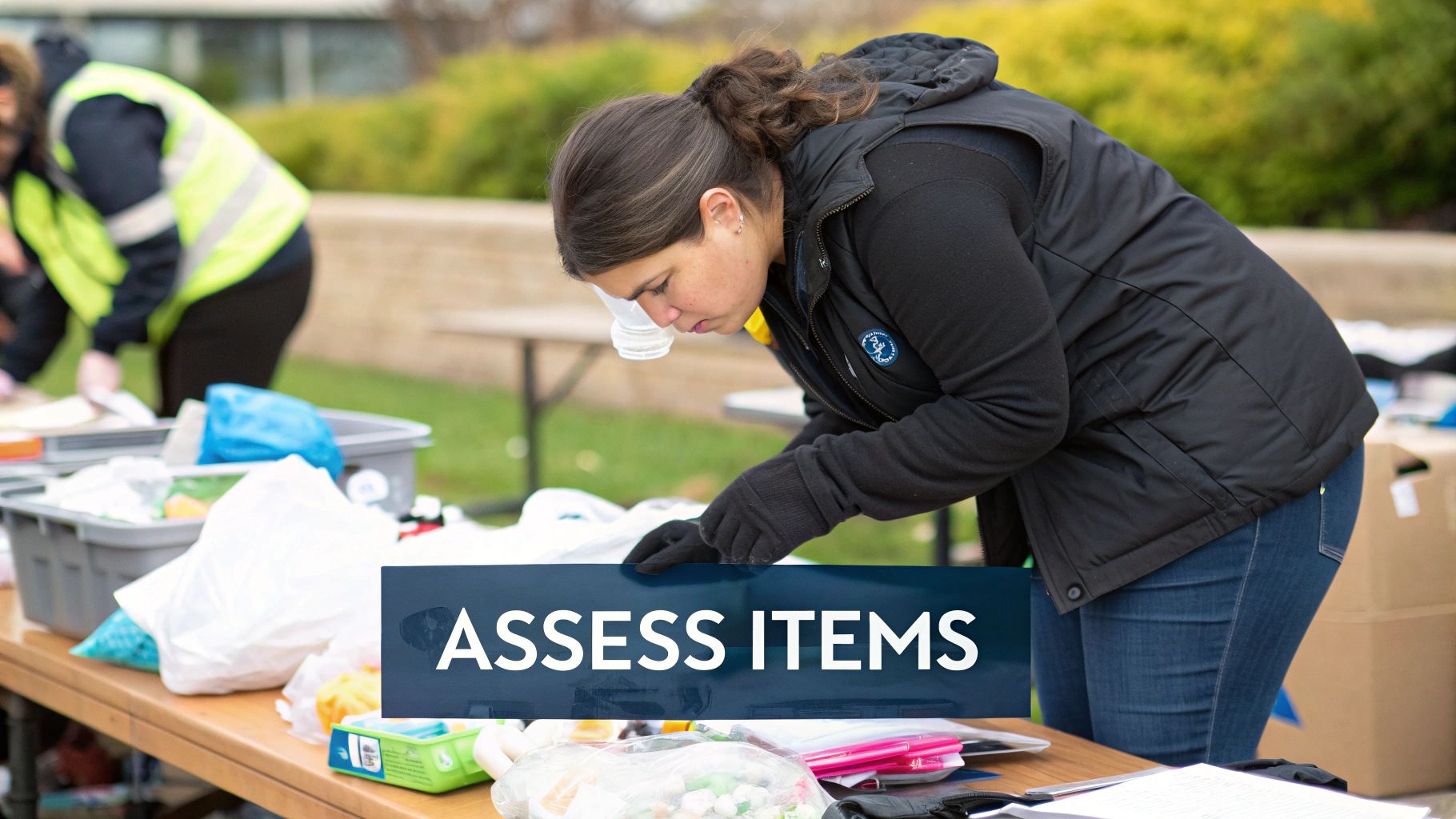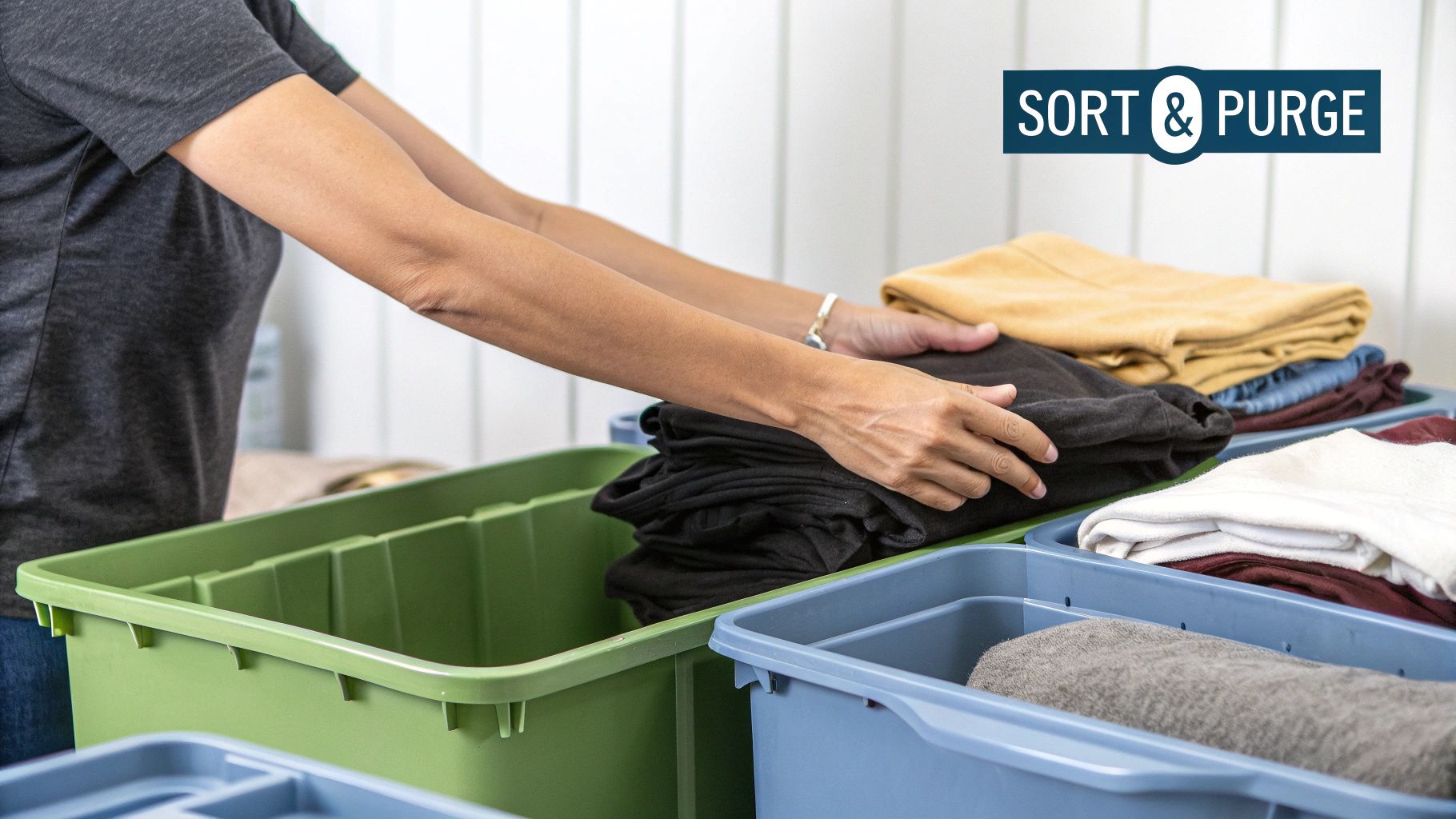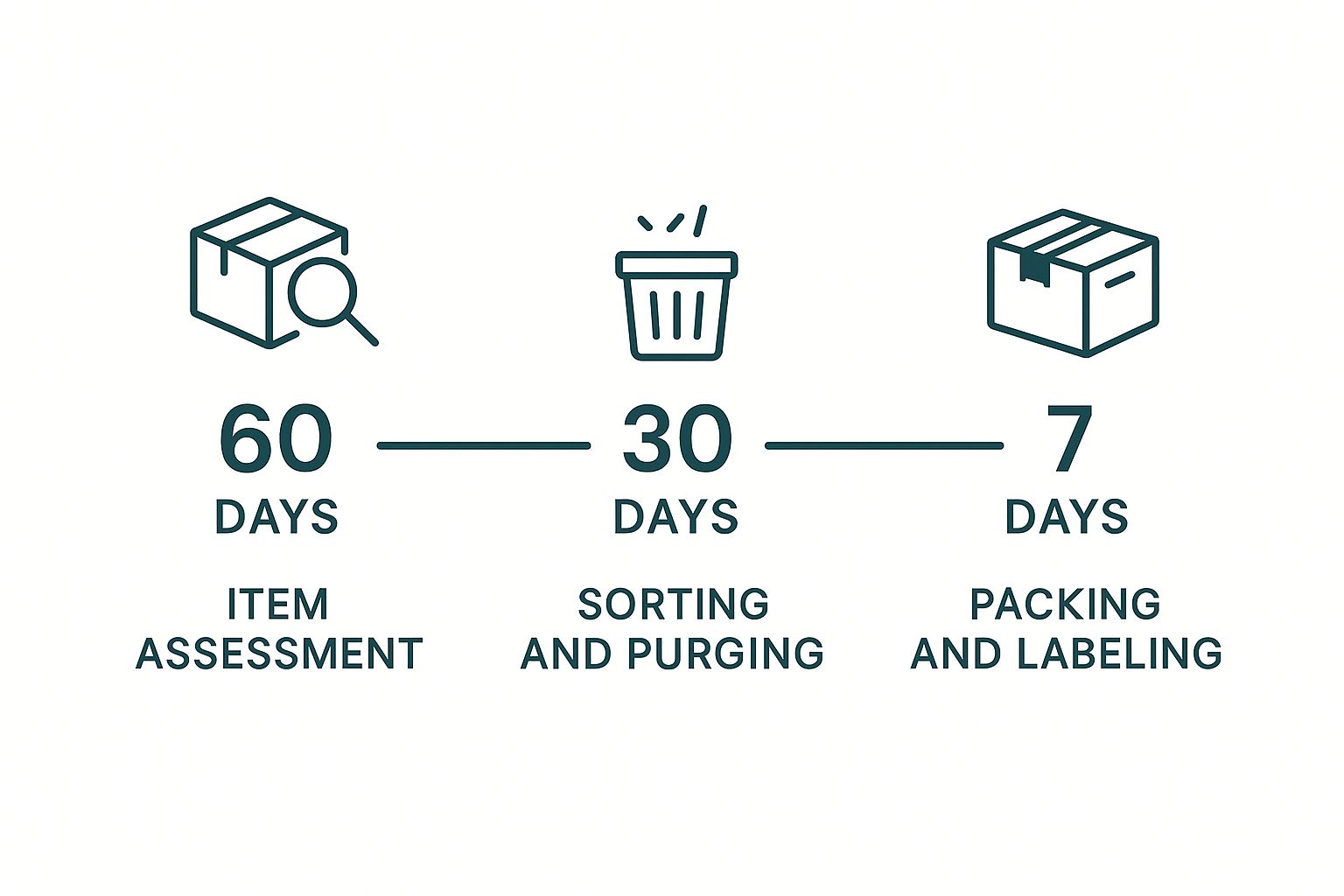Moving house is a major life event, and I can tell you from experience that taking the time to declutter before moving is the single best thing you can do to cut costs, save time, and keep your stress levels in check. It turns the mammoth task of packing into a strategic advantage for a genuinely fresh start.
Your Essential Pre-Move Decluttering Game Plan

Let's be honest, the idea of sorting through years of accumulated belongings can feel paralysing. We all have those cupboards and corners where things pile up, with the promise that we'll deal with them "one day". When a house move appears on the horizon, that "one day" suddenly becomes today, and the pressure is on.
But what if you could sidestep the chaos entirely?
Instead of paying removal companies to move items you no longer need, only to have them sit gathering dust in a new loft or garage, this game plan is all about making conscious decisions before you pack a single box. The goal is to arrive at your new property with only the things you truly use and love, setting the stage for a more organised life from day one.
And if you're selling, this isn't just about making your move easier; it's about making your property more attractive. For more on that, take a look at our guide on how to prepare your house for sale.
The Power of a Simple Sorting System
To avoid that feeling of being completely overwhelmed, we're going to use a simple five-category framework. This system takes the guesswork out of the equation and gives every single item a clear, non-negotiable destination. I've used this method with countless clients, and it works because it’s methodical.
The principle is simple. Get yourself five big boxes, bags, or even just designated corners of a room, and label them:
- Keep: The non-negotiables. These are the items you use regularly, treasure, or can't live without. They are definitely coming with you.
- Sell: Things that are in good nick but no longer serve a purpose for you. This is a great way to put a bit of extra cash in your pocket for the move.
- Donate: Give useful items a second life by dropping them off at your local charity shop.
- Recycle: Paper, glass, certain plastics, and other materials that can be properly recycled by your local council.
- Discard: This should be your last resort. It's for anything broken beyond repair, expired, or genuinely unusable.
The 5-Category Decluttering Framework
To make this even clearer, here's a quick summary of the system. Sticking to these five distinct paths for your items will prevent you from second-guessing every decision.
| Category | Action | Best For |
|---|---|---|
| Keep | Pack it for the move | Everyday essentials, sentimental items, things you love |
| Sell | List online or take to a car boot sale | Good-quality furniture, electronics, clothes |
| Donate | Drop off at a charity shop | Books, usable kitchenware, toys, unworn clothing |
| Recycle | Place in appropriate recycling bins | Paperwork, glass bottles, cardboard, plastic containers |
| Discard | Bag it up for the rubbish collection | Broken items, expired goods, anything beyond saving |
By breaking it down like this, you're not just throwing things away; you're actively deciding what your new home will look and feel like.
By focusing on what to keep rather than what to get rid of, you reframe the entire process. It shifts your mindset from one of loss to one of purpose. You aren't just chucking stuff out; you are curating the life you want to live in your new space.
This approach has a tangible impact if you’re selling your property. In fact, decluttering is statistically proven to boost home sales in the UK market. Reports consistently show that well-presented homes can sell up to three times faster than cluttered ones because they allow potential buyers to actually visualise themselves living there.
A great rule of thumb to get you started is the "One-Year Rule"—if you haven't used it, worn it, or even thought about it in the last 12 months, it's probably time to let it go.
A Room-by-Room Guide to Smart Sorting

Alright, you’ve got your sorting categories ready. Now for the real work. The trick to getting this done without feeling completely overwhelmed is to tackle your home one room at a time. It stops the chaos from spreading everywhere and gives you that brilliant sense of accomplishment as you tick each space off the list.
My advice, from years of experience, is to start with the path of least resistance. Begin somewhere with low traffic and not much emotional baggage—think the loft, garage, or a spare guest room. These areas are usually full of stuff you’ve stored away and forgotten about, which makes the decisions a lot quicker and less sentimental. Clearing them out first builds some serious momentum for the tougher rooms ahead.
Navigating the Clutter Hotspots
Once you’ve got a couple of easy wins under your belt, you can move on to the high-traffic, high-clutter zones. The kitchen, master bedroom, and living room tend to hold the most 'stuff' and need a more methodical approach.
Take the kitchen, for example. Don't just open a cupboard and stare. Pull everything out from a single category, like all your pots and pans, or every single mug you own. When you see those ten chipped, unloved mugs sitting next to your two absolute favourites, letting the others go suddenly becomes a much easier decision.
The same goes for your wardrobe. You have to be a bit ruthless here. Pull it all out. If you haven't worn something in the past year, if it no longer fits, or if it just doesn't suit the life you’re building in your new home, it’s time to say goodbye. It’s as much a psychological step as a practical one, and it makes a huge difference to the move.
Making Tough Decisions with Confidence
At some point, you’ll hit a wall. You'll pick something up and just feel stuck. This is where asking the right questions becomes your secret weapon. Don't just ask, "Do I want this?". You need to frame it with the move in mind.
Before you put an item in the 'Keep' pile, ask yourself two critical questions: "Would I pay a removal company to move this?" and "Does this item serve my future life, or just my past one?"
These questions shift your perspective from just owning things to actively curating your life. If the answer to either is no, you’ve got your decision. And remember, once you’ve sorted an item, it needs to be properly organised for the move itself. For expert advice on that part, check out our essential moving house packing tips.
- For Sentimental Items: You don’t have to get rid of every memory. I always suggest creating a single, dedicated 'memory box' for the small, truly irreplaceable keepsakes.
- For Children's Artwork and Photos: The sheer volume can be overwhelming. Pick a few standout pieces to frame and then digitise the rest. Taking good-quality photos of their artwork creates a wonderful digital album, preserving the memory without the physical clutter.
This targeted, room-by-room approach, combined with asking the right questions, transforms decluttering from a dreaded chore into a manageable—and even empowering—process.
How to Responsibly Rehome Your Unwanted Items

You’ve sorted your belongings into piles, and the hardest part feels like it should be over. But now comes the real challenge: getting rid of everything you don't need without just chucking it all in a skip.
Thinking about how to declutter before moving isn’t just about making space. It's your chance to give your things a second life, whether that’s with a new owner, a local charity, or a recycling centre. This is how you turn potential waste into something genuinely useful and avoid mindlessly filling up landfill sites.
Turning Clutter into Cash
For anything in good nick that you no longer need, selling is a brilliant way to make a little cash to put towards the moving costs. Not all platforms are created equal, though, so picking the right one makes a huge difference.
- Vinted is my go-to for clothes, shoes, and smaller accessories. There are no seller fees, which is a huge plus, and the buyer sorts out the postage. It’s incredibly user-friendly.
- Facebook Marketplace is king for furniture or bulky items you can’t be bothered to post. It’s all about local collection, so you avoid the faff of shipping. Just be sure to price your items competitively.
- eBay still has the biggest audience, especially if you’re selling niche collectibles, retro tech, or branded electronics. Just remember to factor their fees into your asking price.
A quick tip from experience: good photos are non-negotiable. Always shoot in natural daylight against a neutral background. Be honest and show any scuffs or marks. A clear, well-lit picture is often the only thing separating a quick sale from an item that just sits there for weeks.
The Art of Charitable Giving
Donating is a fantastic way to support your local community, and it feels good, too. Most high streets are lined with charity shops, but it’s always worth a quick call to see what they’re accepting before you turn up with bags and boxes.
For larger pieces, many UK charities like the British Heart Foundation or Sue Ryder offer free collection services for furniture. This is a lifesaver when you're in the middle of packing.
Just make sure everything you donate is clean and in working order. Charities spend a fortune disposing of items they can't sell, so a little bit of effort from you ensures your donation is a help, not a burden.
Sustainable Disposal for Everything Else
Let’s be realistic—some things just can't be sold or donated. For everything else, responsible disposal is the final piece of the puzzle. Your local council website is your best friend here.
Look up their services for:
- Bulky Waste Collection: Most councils will collect big items like old mattresses or a broken wardrobe for a small fee. You usually book a slot online.
- Household Waste Recycling Centres: Your local tip is the place for a huge range of materials, from wood and garden waste to old carpets and scrap metal.
- WEEE Recycling: This one is crucial. Waste Electrical and Electronic Equipment (WEEE) like old kettles, phones, or toasters contain materials that can be harmful if they end up in landfill. They must be recycled properly. Look for the special WEEE bins at your recycling centre or even at large retailers.
By taking these final steps, you can be confident your decluttering has been as good for the planet as it has for your own peace of mind.
Using Self Storage to Simplify Your Move
Let’s get one thing straight: decluttering before a move doesn’t have to mean saying a final goodbye to your belongings. Sometimes, you just need to get things out of the way to give yourself some breathing room. This is where a bit of strategic self-storage can turn a frantic, box-filled move into a far calmer, more organised process.
Think of it as a temporary waiting room for your possessions. It’s an absolute game-changer in a few common moving scenarios. For instance, if you’re downsizing but can’t bear to part with treasured furniture just yet. Or maybe you're staging your home for sale and need to clear out the clutter to create that minimalist, buyer-friendly look. It's also a lifesaver when there's an awkward gap between your move-out and move-in dates.
Finding the Right Storage Solution
Choosing a storage unit isn't just about grabbing the cheapest one you can find. It's a balancing act between cost, size, and security. You don’t want to get stuck paying for a cavernous unit when you only need to fill half of it.
- Estimate Your Space: Before you start looking, get a rough idea of what you actually need to store. As a rule of thumb, the contents of a one-bedroom flat usually fit comfortably into a 50-75 square foot unit. A three-bedroom house? You're probably looking at 150 square feet or more.
- Location and Access Matter: A facility miles out of town might look cheaper on paper, but the travel time and petrol costs quickly add up. Look for a place with access hours that work for you – ideally 24/7. The last thing you need is to be locked out when you desperately need that one specific box.
- Don't Skimp on Security: Your things are valuable, so this isn’t the place to cut corners. Check for essentials like good lighting, gated access, and CCTV. For a deeper dive, our guide on what to look for in secure self storage is a great starting point.
Using self-storage has become a standard part of moving house in the UK. A recent report from the Self Storage Association revealed that a massive 44% of domestic storage use is now directly linked to moving, a huge jump from just 32% the year before. This isn't surprising. It shows just how many homeowners, especially those downsizing, need that extra flexibility. You can read more about what’s driving this trend in the latest MoverAlerts report.
Using storage lets you unpack and settle into your new home on your own terms. Instead of navigating a fortress of boxes, you can bring items from your storage unit as you need them, allowing you to design your new space thoughtfully and without pressure.
By giving some of your items a temporary home, you're really giving yourself the gift of time and space. It frees you up to focus on the immediate chaos of moving day and settling in, knowing your other possessions are safe and sound until you're ready for them. It’s a simple, practical step that can make a world of difference.
Your 8-Week Pre-Move Decluttering Timeline
Right, let’s get practical. To stop this from feeling like one huge, impossible task, we need a plan. Think of the next eight weeks as a countdown. Breaking the decluttering marathon into a series of weekly sprints makes everything far more manageable and keeps you on track for a calm, organised moving day.
This is the roadmap I give to all my clients to turn chaos into a clear, step-by-step process.

As you can see, the secret is to flow from big, easy decisions to the small, fiddly stuff later on. You build momentum without trying to do everything at once.
To make this even easier, here’s a quick-glance countdown checklist. It outlines the key tasks for each period, helping you focus on what matters most at each stage of the process.
8-Week Decluttering Countdown
| Timeframe | Key Tasks | Primary Goal |
|---|---|---|
| 8 to 6 Weeks Out | Book removal company, declutter loft/garage, list large items for sale. | Lock in a moving date and tackle the easiest, least emotional areas first. |
| 5 to 4 Weeks Out | Go room-by-room, schedule charity collections, pack non-essentials. | Systematically clear main living areas and get unwanted items out of the house. |
| 3 to 2 Weeks Out | Purge kitchen & bathroom, confirm all bookings, final donation run. | Clear out high-clutter zones and finalise all third-party arrangements. |
| The Final Week | Pack "first night" box, final clutter sweep, defrost fridge/freezer. | Focus on essentials for moving day and immediate arrival. |
This table is your blueprint. Pin it to your fridge, save it to your phone—whatever you need to do to keep it front and centre for the next two months. Now, let's break down what each stage looks like in the real world.
8 to 6 Weeks Out: The Big Picture
This phase is all about strategy and getting some early wins on the board. The goal here is to tackle the big, dusty areas first to give yourself a real sense of progress.
- Book Your Removal Company: This is non-negotiable. Get a few quotes and book your movers. Having a firm date in the diary makes the whole thing real and gives you a hard deadline to aim for.
- Tackle the Low-Hanging Fruit: I always tell people to start with the loft, the garage, or the shed. Why? Because these spaces are usually full of things you haven't seen or used in years, making the decisions far less emotional and much quicker.
- List Big-Ticket Items for Sale: If you’re planning to sell furniture, large appliances, or that lawnmower you never use, list them online now. Finding a buyer and arranging for them to collect can easily take a few weeks. Don’t leave it until the last minute.
5 to 4 Weeks Out: Getting into the Nitty-Gritty
With the big spaces cleared, it’s time to move into the main house. You’ll also start arranging the logistics for everything you’re letting go of.
- Go Room by Room: Now’s the time to work through the bedrooms, living room, and home office. Be methodical. Take your five boxes or piles—Keep, Sell, Donate, Recycle, Discard—and be ruthless.
- Arrange Charity Collections: If you have bulky items like furniture or a mountain of bags for donation, call your local charities now to get a collection booked in. Their schedules can fill up weeks in advance.
- Start Packing Non-Essentials: This is a great time to begin boxing up things you know you won’t need for the next month. Think out-of-season clothes, books you’ve already read, decorative ornaments, and that fancy dinner service you only use at Christmas.
A quick pro-tip on labelling: don’t just write "Kitchen" on a box. Be specific. A good label says, "Kitchen – Glassware & Mugs" or "Main Bedroom – Winter Jumpers & Scarves." Trust me, you’ll thank yourself when you’re tired and trying to find the kettle on moving day.
3 to 2 Weeks Out: The Final Purge
The moving date is getting much closer now. Your focus should be on clearing out the last pockets of clutter and continuing your methodical packing.
- Kitchen and Bathroom Purge: These two rooms are notorious clutter magnets. It's time to go through every single cupboard. Get rid of expired spices, half-used toiletries, and that collection of old cleaning products under the sink.
- Confirm Your Services: Make a quick call to your removal company to confirm all the details. If you've booked a self-storage unit, double-check your move-in date and access times.
- Hold a "Final Call" Donation Run: This is your last trip. Load up the car with any remaining bags and boxes of donated items and take them to the charity shop.
The Final Week: Finishing Touches
This week is all about final preparations. By now, the major decluttering decisions should be done and dusted. The last few days are for packing and cleaning, not for debating whether to keep that old university textbook.
- Pack Your "First Night" Box: This is your survival kit, and it’s the most important box you’ll pack. It should contain absolute essentials: toiletries, a change of clothes, phone chargers, tea and coffee supplies, a small toolkit, and any crucial documents. Crucially, keep this box with you in the car, not on the removal van.
- Final Clutter Sweep: Do one last walkthrough of the entire house. Open every cupboard, every drawer, and check behind every door. It's amazing what can hide in plain sight.
- Defrost the Fridge/Freezer: Make sure your fridge and freezer are completely empty, defrosted, and cleaned at least 24 hours before the movers are scheduled to arrive. Nobody wants to deal with a dripping, smelly appliance on moving day.
Got Questions About Decluttering for a Move?
Even the best-laid plans hit a snag. When you're knee-deep in boxes and decisions, it’s completely normal for questions to pop up. It's a massive job, after all.
Let's tackle some of the most common queries I hear, with practical answers to keep you on track and feeling confident.
Where on Earth Do I Start the Decluttering Process?
The golden rule? Start with the area you have the least emotional attachment to. For most of us, that's the loft, the garage, or that spare bedroom that’s become a dumping ground. These spaces are usually full of stuff you’ve stored and forgotten about, making the decisions much faster and less sentimental.
Starting here gives you a quick win. You’ll build momentum and see real, tangible progress straight away. That sense of accomplishment is incredibly motivating and arms you with a more decisive mindset for when you finally have to tackle the sentimental hotspots, like your bedroom or the home office.
How Do I Get Rid of Large, Unwanted Furniture?
Big, bulky furniture doesn't have to be a massive headache. If it’s in decent nick, your best bet is selling it locally on platforms like Facebook Marketplace or Gumtree. The beauty of these sites is that buyers are expected to collect, which saves you from wrestling with complicated and expensive postage.
A lot of UK charities, including the British Heart Foundation and Sue Ryder, actually offer free collection services for large furniture that’s in good, reusable condition. It's a fantastic, zero-hassle way to donate and help a good cause at the same time.
For furniture that’s seen better days and isn't suitable for donation, your local council is your next port of call. Head over to their website and look for their bulky waste collection service. There’s usually a small fee, but it guarantees it’s all disposed of properly.
What’s the Best Way to Handle Sentimental Items?
This is, without a doubt, the toughest part of any pre-move clear-out. The goal here isn't to be ruthless; it's to be selective. You want to preserve the memory without being burdened by the physical object itself.
Here’s an approach that works for many:
- Create a single "memory box." Find one sturdy box and dedicate it to the small, truly irreplaceable things. Think a few special letters, your child's first pair of shoes, or treasured family heirlooms. One box. That's the rule.
- Go digital with the rest. What about all that children’s artwork, old photos, or even sentimental but bulky objects? Take high-quality photographs of them. You can create a digital album that saves the memory forever without taking up a single inch of space in your new home.
This strategy lets you honour your past without letting it clutter your future. And if you have more questions about the big day itself, you’ll find a wealth of information in our comprehensive moving house FAQs.
Feeling overwhelmed by the thought of planning your move? You don’t have to do it alone. Euro Move Direct provides seamless removal services across the UK and beyond, with a professional team ready to make your transition smooth and stress-free. From local moves to international relocations and secure storage solutions, we’ve got your back. Get your free, no-obligation quote from Euro Move Direct today and let us handle the heavy lifting.